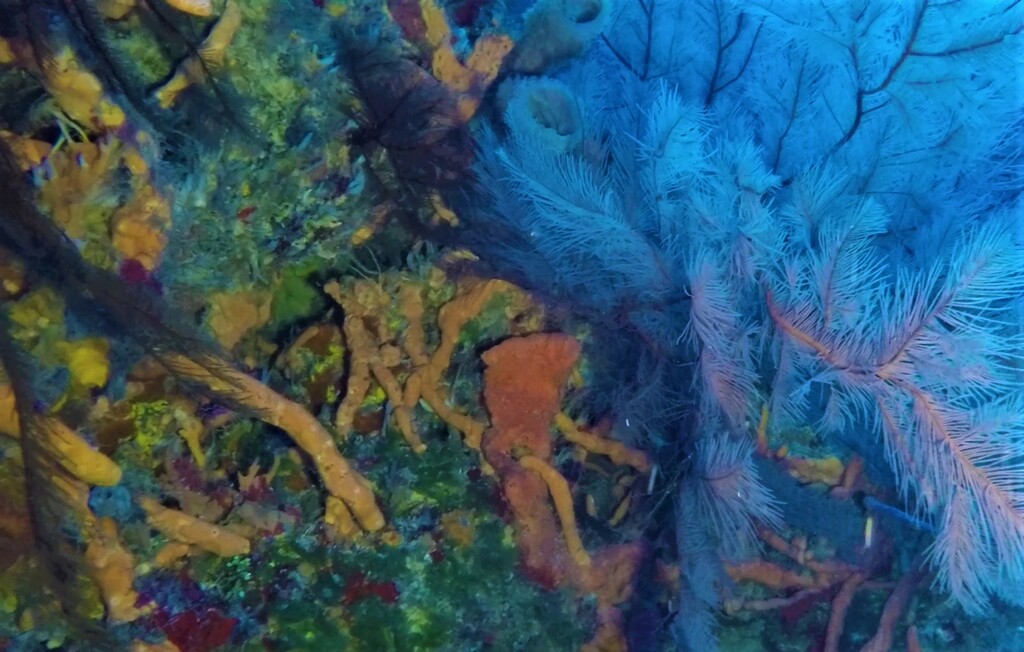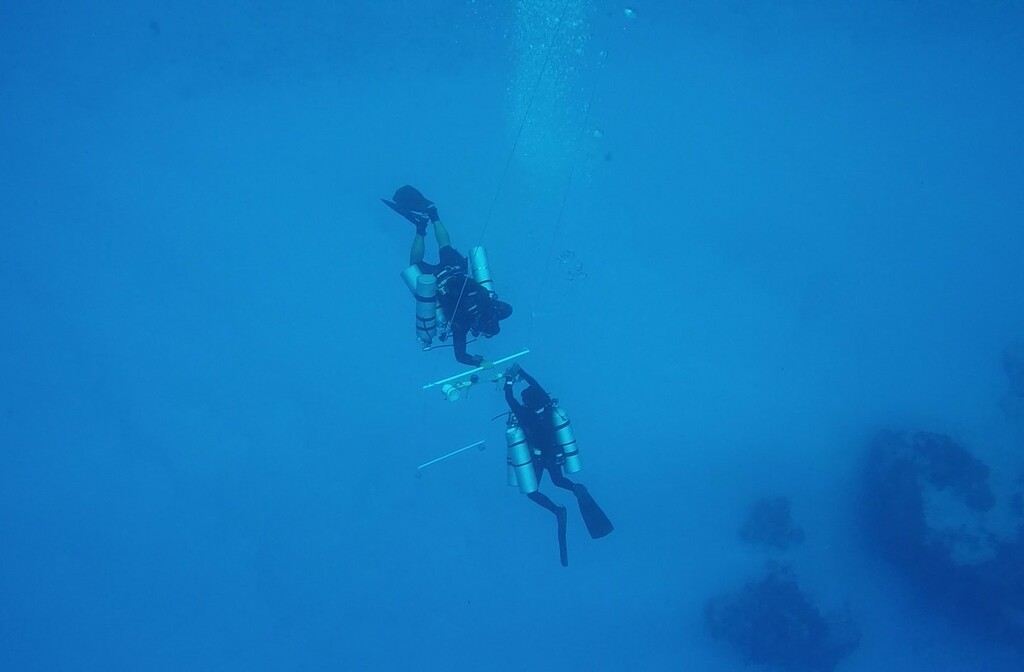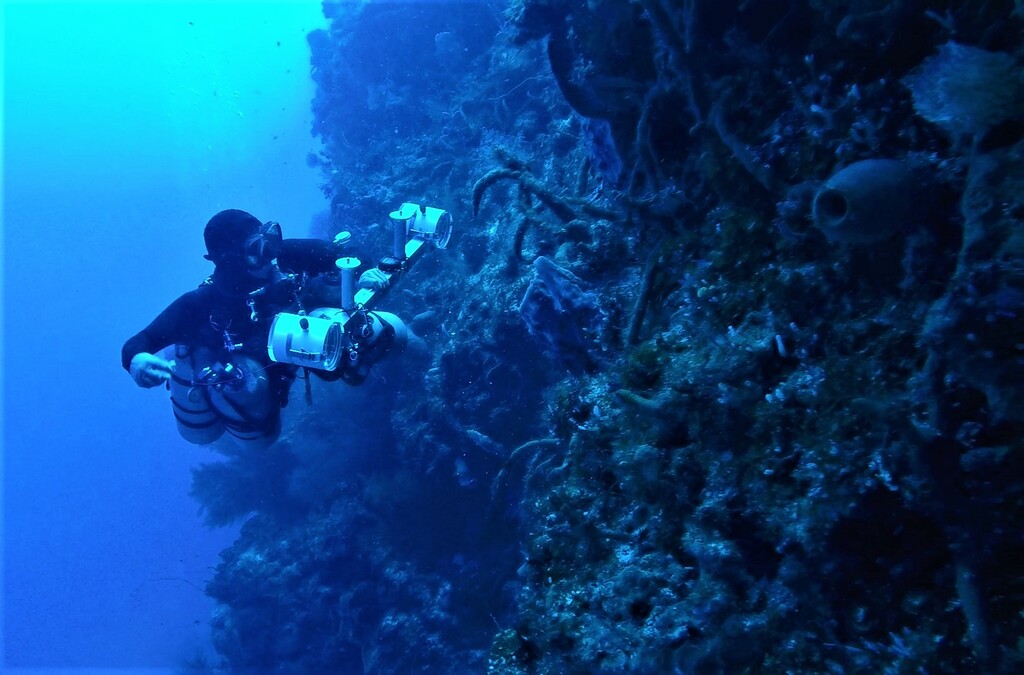Behind the science:
Assessing mesophotic coral ecosystems inside and outside a Caribbea...
2019, October 19
Posted by Veronica Radice
Fields
Ecology
Management and Conservation
Biodiversity
Community structure
Disturbances
Focusgroups
Fishes
Overall benthic (groups)
Locations
Mexico - Caribbean Sea
Platforms
SCUBA (open-circuit or unspecified)
“Management of mesophotic coral reefs: a Caribbean case study”
What was the most challenging aspect of your study (can be anything from field, lab to analysis)?
Currents in the west side of Cozumel are particularly strong and variable, making them difficult to predict. For the fish and black coral surveys, we filmed along our transects and then analysed the footage using the EventMeasure software. Slowing down, or swimming against current while keeping the cameras in the right position was rather challenging sometimes.
What was the most memorable moment in undertaking this study?
One of the most memorable moments underwater was when we surveyed the first site outside the marine protected area and realised that MCEs were not as affected as shallow reefs in this area. Another memorable moment that resulted from this study – outside the water – was when I was given the news that MCEs were going to be acknowledged in the Cozumel MPA management plan, and that targeted Antipatharians (black corals) were going to be included in the national protected species list.
 Mesophotic Coral Ecosystems (MCEs) inside the Cozumel MPA showing sponges and black corals at 55 m depth.
(C) Erika Gress
[CC BY-NC 4.0]
Mesophotic Coral Ecosystems (MCEs) inside the Cozumel MPA showing sponges and black corals at 55 m depth.
(C) Erika Gress
[CC BY-NC 4.0]
 Erika Gress and Dominc Andradi-Brown during deco stop
(C) Gina Wright
[CC BY-NC 4.0]
Erika Gress and Dominc Andradi-Brown during deco stop
(C) Gina Wright
[CC BY-NC 4.0]
What was your favorite research site in this study and why?
My favourite research site was Palancar Jardines, one of the sites further south of the island. MCEs there are stunningly colourful and complex (structure wise). In general, the sites further south have higher abundance of hard corals, black corals and sponges; and of fish as well. More research is still needed to determine if such pattern is due to their latitudinal position, their distance from the main town or due to particular environmental parameters.
Other than your co-authors, with whom would you like to share credit for this work?
I appreciate the support offered by Kiragu Mwangi, Stuart Paterson and Christina Imrich from Conservation Leadership Programme (CLP) throughout the whole process of this study. Cristopher Gonzales and Blanca Quiroga from the Cozumel Marine Park (CONANP) have been cooperative and willing to advance research and protection of MCEs in Cozumel. Also, I am grateful to Alex Rogers (University of Oxford) for his support and encouragement.
 Erika Gress about to start a SVS (stereo-video system) transect survey at 55 m depth.
(C) Dominic Andradi-Brown
[CC BY-NC 4.0]
Erika Gress about to start a SVS (stereo-video system) transect survey at 55 m depth.
(C) Dominic Andradi-Brown
[CC BY-NC 4.0]
Any important lessons learned (through mistakes, experience or methodological advances)?
Precisely because of the strong currents, the technique of reeling (out and in) a transect tape to determine distance of transects and quadrats position for benthic communities’ assessment couldn’t be used. We had to use biodegradable pre-marked thread which required a lot of time to prepare before each dive. It would be ideal to have access to an electronic apparatus that could indicate us, in real time, the distance we have travel underwater.
Can we expect any follow-up on this work?
Yes, I am are already planning and arranging things to be able to follow-up on this project. This study represents the first quantitative assessment of MCEs in Mexico, although we only conducted surveys at the upper-mesophotic depths (30-60 m) and on a few sites. Also, I am planning to assess other MPAs in the region.
_colony_at_55_m_outside_the_MPA.jpg) Erika Gress in front of a Plumapathes pennacea (black coral) colony at 55 m depth outside of the MPA.
(C) Dominic Andradi-Brown
[CC BY-NC 4.0]
Erika Gress in front of a Plumapathes pennacea (black coral) colony at 55 m depth outside of the MPA.
(C) Dominic Andradi-Brown
[CC BY-NC 4.0]
Featured article:
|
|
Assessing mesophotic coral ecosystems inside and outside a Caribbean marine protected area | article Gress E, Arroyo-Gerez MJ, Wright G, Andradi-Brown DA (2018) R Soc Open Sci 5:1-17 |

|
.png)